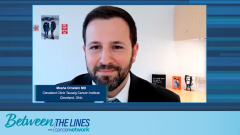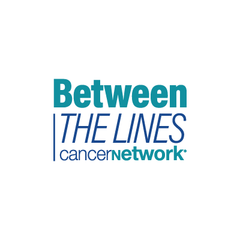
Choosing a Combination Treatment for Advanced Renal Cell Carcinoma
A look at the factors considered in choosing an appropriate combination treatment for advanced renal cell carcinoma.
Episodes in this series

Brian Rini, MD: Do you think these data are better? Or are they just different—different time, the vagaries of different phase 3 trials? My second question is, if a PFS [progression-free survival] is impressive at 24 months, the hazard ratios for all these trials settle in at 0.7. We’re not seeing those tumor shrinkage advantages translate into survival. Comment on both of those if you would.
Moshe Ornstein, MD: With the first 1, when you put an I/O [immuno-oncology] and a TKI [tyrosine kinase inhibitor] together, there’s obviously going to be a lot of debate about to what extent there’s a difference among the I/Os and among the TKIs. Everyone has their own choice of TKI that they find to be either the best or the easiest to handle. I’m not convinced that there’s a demonstrable difference with any of these regimens.
A couple of things that stand out from this trial may have produced these kinds of results. The dose of lenvatinib, for instance, was 20 mg, which is higher than we would use when we use lenvatinib with everolimus in the refractory setting. When you look at cabozantinib-nivolumab, the dosage of the cabozantinib was 40 mg per day; in the refractory setting it would be 60 mg. For axitinib and pembrolizumab, we would start axitinib at about 5 mg. We can up titrate, but we have a basic starting dose.
One argue that the reason we see this response rate, the reason we see this PFS, is because of that high lenvatinib dose; that’s certainly a possibility. That might also be what’s translating into the higher PFS. I don’t think it’s clear, and I don’t think we can fairly say across trials that this is the best 1. But at the end of the day, these are what the data demonstrate. Either option is reasonable. More important than looking at the absolute PFS, the absolute response rate, etc, is how long we can keep patients on treatment and how well we can manage their toxicities, because these drugs are only good if we can keep them in the patients. But from a high-level perspective, the data seem to favor this regimen with all the caveats I mentioned with dosing.
Another thing is that the other trials that have come before have given us more experience with managing I/O–TKIs. It’s possible that some results in this trial are by nature of this being the last 1 to read out, and physicians treating patients have had more experience managing patients on these regimens.
Brian Rini, MD: Based on the absolute data, it sounds like you’ve turned to this as your go-to I/O–TKI regimen. Is that fair to say?
Moshe Ornstein, MD: For an I/O–TKI, for a young, healthy patient, I’m going to likely choose this regimen. I have a lady in her 80s who’s got a bunch of comorbidities. Maybe I’m a little more nervous about using a TKI with a longer half-life, etc. For that patient who walks in, if I want an immediate response and a good PFS, I’m favoring this more. Previously, I was in between axitinib-pembrolizumab and cabozantinib-nivolumab. I’m curious, have you shifted at all when you look at these data?
Brian Rini, MD: Yes, I was a big axitinib-pembrolizumab user, as you know. I still am, and I’ll explain that in a second. When cabozantinib-nivolumab came out, I view those data as broadly similar to axitinib-pembrolizumab. The numbers and the hazard ratios are similar, and it came down to that TKI choice and being very comfortable with axitinib and axitinib-pembrolizumab. I didn’t switch. When these data came out with all the caveats that you mentioned, they seemed to stand off the page a little. That’s balanced against toxicity, which we’ll get to next, but I’ve gone to this as my go-to regimen.
Having said that, a solid 30% or 40% of patients who walk into my clinic don’t pass the eyeball test. This patient is not going to tolerate lenvatinib-pembrolizumab, certainly not at 20 mg. For those patients, I default to axitinib-pembrolizumab. Everybody is settling into their proportions and favor a regimen, but that’s how I do it.
Mehmet Asim Bilen, MD: It’s a good point. I tend to say, this is what we do as a standard for the patient who we think we can get through this regimen. But maybe 5 or 10 years ago, before I/O–TKIs, we weren’t sure how well they would handle a TKI in general. Or for a patient for whom I want to be able to drop the TKI quickly and resolve some of those toxicities, I lean more toward axitinib-pembrolizumab, knowing that the toxicity management from where I sit is easier to manage.
I tend to use the shorter half-life, at least if there’s something we can turn off quicker. For that, axitinib is the winner because the half-life is the shortest. In terms of the site of metastases, if I have a patient with liver metastases or bone metastases, we know biology tends to be on the aggressive side. I may choose my most potent VEGF TKI: cabozantinib or lenvatinib. In terms of bone metastases, we have data for cabozantinib as a single agent and some biology around it. Because of this, I tend to choose nivolumab-cabozantinib. But all those are based on the clinical picture. It’s not a predictive biomarker because of this reason. We don’t have any level 1 evidence, like what we do and how we do.
Brian Rini, MD: Agreed. We’d all like biomarkers to select individual regimens for individual patients, but we haven’t done a great job discovering those to date. I was a big axitinib-pembrolizumab user for a long time. I still am, with the data that we talked about and the high response rates and the very long PFS. I’ve shifted to lenvatinib-pembrolizumab. I want to talk about toxicity in a minute, but it’s a more toxic regimen. It’s more challenging to give, especially at 20 mg. Some patients who walk in don’t pass the eyeball test to get this regimen. For them, I’ll revert back to axitinib-pembrolizumab.
I haven’t been a big cabozantinib-nivolumab user. I see those data as very similar to axitinib-pembrolizumab, and I have a lot more familiarity with axitinib-pembrolizumab, especially with the short half-life of axitinib, as you mentioned. That tends to make it a little easier to use in clinic—a little more patient-friendly, in my opinion. But usually, I relay in sessions like this that we’re blessed to have many good regimens. It’s probably more important to get to know a regimen well in dosing and modifications and when to hold drug and the nuances of an individual regimen, rather than to worry too much about whether you’re choosing A, B, or C.
Transcript edited for clarity.
Newsletter
Stay up to date on recent advances in the multidisciplinary approach to cancer.










































































































